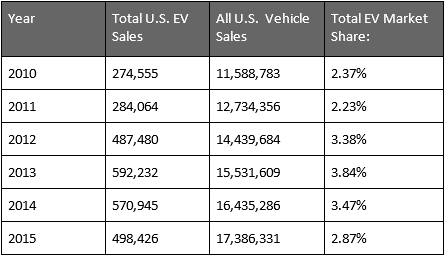When it comes to electric vehicles (EV), there’s probably no worse an epithet than this one: “compliance car.”
That’s the name auto insiders started applying a few years ago to the EVs now for sale by the major automakers in the United States. And why?
Because of your not-so-friendly regulators over at the Environmental Protection Agency (EPA) and the California Air Resources Board (CARB). In fact, these very regulations are going to have a significant impact on automakers during the next several years…
You see, automakers are stuck between a rock and a hard place. They have a couple of big deadlines to meet:
- By 2025, California requires that about 15% of the new vehicles for sale in the state be so-called “ZEVs,” or zero-emissions vehicles.
- Likewise, in the same year, EPA regulations require car companies’ new car fleets to have an average fuel efficiency of 54.5 miles per gallon of gasoline.
What happens if an automaker doesn’t comply with California standards? The good folks at CARB levy a fine of $5,000 on every new car the company wants to sell in the state.
The EPA’s miles-per-gallon requirement is problematic too. According to the feds, the total U.S. fleet had an mpg average of 31.5 in 2014. It improves a little bit each year, but not at a pace to hit 54.5 in the next nine years.
Solution? Get busy rolling out lots of EVs — electrically powered vehicles.
But the problem is that most Americans don’t want and can’t afford electric vehicles, leaving automakers trapped meeting government regulations to save on fines while producing cars they can’t sell. It’s another case of the government being out of touch with reality.
The Quest for EV Nirvana
According to the IHS research firm, auto companies introduced more than 50 electric models in the last five years, with many more to come.
For an automaker, the idea is to build just enough EV models to meet the California mandates. Sure, your electric vehicles will lose money, but you’re getting credit for the EVs’ 100-mpg fuel ratings. In the bargain, you can still sell lots of gas-guzzling Escalades, Navigators and F-150s (all highly profitable vehicles to make and sell) — and still come out with a fleet-wide average of 54.5 mpg when 2025 rolls around.
There’s just one problem: Not many people appear to actually want an electric vehicle.
Check out the table from the Electric Drive Transportation Association:

The EV sales figures here include hybrid cars, which use a gasoline engine as the vehicle’s primary power source. What happens if you only include so-called “plug-in” hybrids (like the Volt, which uses electrical power to turn the wheels, but also carries an onboard gasoline-powered generator to charge up the car’s battery for extended driving range), as well as battery-only vehicles?
The market share for electric vehicles shrinks to less than 1%.
So there it is in hard facts. A few vehicles, such as Tesla’s $100,000 Model S, are big niche sellers. But the rest of the EV universe aimed at the “99%”? Meh.
The truth is, most people are indifferent to EVs. But hey, that’s someone else’s problem (if you’re the EPA or CARB).
But if you’re a shareholder of an automaker, it is a problem. It’s a huge expenditure of capital for which there’s almost no return. Except to be “compliant” with regulators, that is.
For instance, Ford recently said it would spend $4.5 billion through 2020 on electric vehicle development. Not every automaker can afford the price tag of the new regulator-mandated EV religion.
Fiat Chrysler falls into this camp. That’s why CEO Sergio Marchionne is an outspoken foe of the EV government mandates, warning back in 2014: “If we build those vehicles, we’ll be back asking in Washington for a second bailout because we’ll be bankrupt.”
Even Toyota, an automaker with huge resources and long-term strategic vision, thinks battery-only zero-emissions vehicles are a waste. The company’s U.S. chief alternative fuels executive told Forbes last year: “We don’t see any battery technology that would allow us to give customers a comparable driving experience at a reasonable price.”
Failing the Electric Battery Acid Test
Ah, and that’s the key — a reasonable price.
The usual refrain among EV fans is that, with enough time and investment, the main cost of the vehicles — the battery pack — will drop way down in cost. The vehicles, so the thinking goes, will finally be cheap enough that ordinary people will want to buy electric vehicles by the millions.
It’s an important point, and a key reason why Tesla received so much attention for building its battery “gigafactory,” currently taking shape in the Nevada desert. A Bloomberg editor even recently forecast a crash in oil prices in the mid-2020s, based on the hypothesis that we’re on the verge of this long-anticipated era of large-selling, economy-priced electric vehicles.
There’s just one problem: the soaring cost of batteries’ raw material.
As car makers (both here and abroad) ramp up production of all these new EV models that nobody really wants to buy, the price of lithium carbonate — the key chemical ingredient for EV batteries — is going through the roof. The price is up by 47% just this year, according to Benchmark Mineral Intelligence.
Tesla hasn’t even turned on the production lines at its Nevada facility yet. According to Goldman Sachs, the Tesla factory would consume as much as 17% of the entire world supply of lithium.
In a December article in The Financial Times, “Tesla in Stand-off Over Lithium Supply,” the car maker has not yet even secured a long-term source of lithium for its battery packs. According to the article, three of the largest suppliers of lithium in the global marketplace “have not been willing to supply at the prices Tesla has demanded.”
“The most likely outcome,” said Joe Lowry, a lithium supply expert, “is Tesla will pay high market prices for lithium through at least the end of the decade.”
Raw materials like lithium comprise 25% of the cost of an EV battery pack. And something else to keep in mind — the ebbing tide in prices for the other elements of an EV battery pack, such as cobalt, nickel and manganese, won’t last forever.
High raw material prices make it tough to build cheap battery packs. Without cheap battery packs, it’s hard to make an affordable “mass market” electric vehicle. If you can’t make a case for mass market electric vehicles, why build a gigafactory, or indeed EVs at all?
Reckless Government Regulation
Government regulation is ahead of the technology curve. Despite the government’s drive to bring down emissions and raise fuel efficiency, Americans just can’t afford it and automakers are paying the price.
You’re not going to see vast fleets of electric cars replacing their gasoline counterparts anytime soon. For better or worse, we’re stuck using oil-derived fuels. Better plan to invest accordingly.
That said, I’d love to see more electric cars on America’s roads, if that’s what we as consumers thought made the most sense. The trouble is, right now, only the emissions regulators in California and the Environmental Protection Agency seem to think that’s the case.
Kind regards,

JL Yastine
Editorial Director, Banyan Hill Publishing




